

Introduction to Clojure. 1.

Introduction Clojure is a functional programming language that runs entirely on the Java Virtual Machine, in a similar way to Scala and Kotlin. Clojure is considered to be a Lisp derivative and will be familiar to anyone who has experience with other Lisp languages. This tutorial gives an introduction to the Clojure language, introducing how to get started with it and some of the key concepts to how it works. 10 life-changing minutes with Clojure (Windows) Easy Clojure, Easy REPL. Have you ever tried to convince a friend that Clojure is a great language?
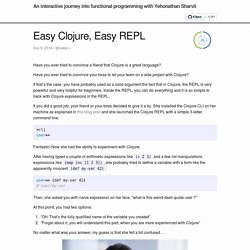
Have you ever tried to convince your boss to let your team on a side project with Clojure? If that’s the case, you have probably used as a solid argument the fact that in Clojure, the REPL is very powerful and very helpful for beginners. Inside the REPL, you can do everything and it is so simple to hack with Clojure expressions in the REPL. If you did a good job, your friend or your boss decided to give it a try. She installed the Clojure CLI on her machine as explained in this blog post and she launched the Clojure REPL with a simple 3-letter command line: Fantastic! After having typed a couple of arithmetic expressions like (+ 2 3) and a few list manipulations expressions like (map inc [1 2 3]), she probably tried to define a variable with a form like the apparenlty innocent (def my-var 42): user=> (def my-var 42)#'user/my-var At this point, you had two options: “Oh!
User=> (def my-var 42) 42. Clojure Programming. Clojure is a dynamic programming language for the JVM.
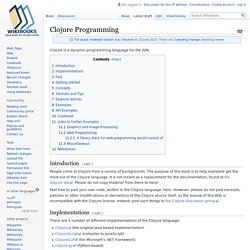
Introduction[edit] People come to Clojure from a variety of backgrounds. The purpose of this book is to help everyone get the most out of the Clojure language. Guides/parsing_xml_with_zippers.md at master · clojuredocs/guides. Getting acquainted with Clojure zippers - josf.info. One last thing that took a while to sink in: zippers are cheap.
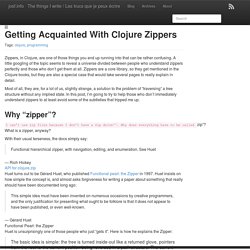
Huet insists on how zippers are supposed to be fast since, in a very clojurey way, only the differences in path and position need to be taken into account, leaving most of the original data intact. In a more concrete way, just looking at a zipper, we see that there isn’t much to them. Here is your data: user> (def your-data [:a :b :c]) #'user/your-data. Feldi/clj-swipl: A Clojure library designed to call SWI-Prolog goals directly from clojure code. Java - How to add directory to Clojure's classpath? How Clojure helps you build powerful abstractions – Cyprien Pannier. Clojure has its own way of doing things, often coming right out of the brain of the smart Clojure creator Rich Hickey.

I’m strongly convinced by nearly all of them, and this is the main reason why Clojure is my preferred language, where Javascript could have been the top one with its recent ES6–7 syntax improvements. Clojure gives you a solid toolbox to write rock solid concurrent code. It is a very opinionated language, and despite of providing good jvm compatibility, it does not always follow the hype of big programming tendances like reactive streams or actor based programming. The truth is Clojure (as the team behind it) has its own innovation path and introduces concepts it sees having a real use case for writing production code. But wait, its not a niche, core async channels for example are directly inspired by Golang.
Let’s describe briefly some of the powerful tools you have at your disposal when going the Clojure way. Clojure vs. The Static Typing World. Clojure vs.
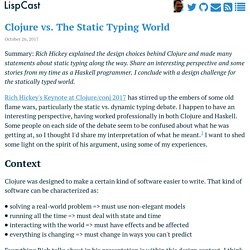
The Static Typing World October 26, 2017 Summary: Rich Hickey explained the design choices behind Clojure and made many statements about static typing along the way. Share an interesting perspective and some stories from my time as a Haskell programmer. I conclude with a design challenge for the statically typed world. Rich Hickey's Keynote at Clojure/conj 2017 has stirred up the embers of some old flame wars, particularly the static vs. dynamic typing debate. Functional XML editing using zippers in Clojure → pckl.me. Since the Clojure documentation for clojure.zip is so bad I thought I'd walk through an example of editing some XML using a zipper.
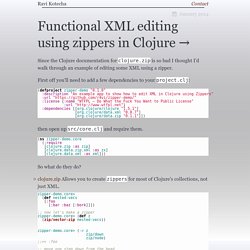
First off you'll need to add a few dependencies to your project.clj: (defproject zipper-demo "0.1.0" :description "An example app to show how to edit XML in Clojure using Zippers" :url " :license {:name "WTFPL – Do What the Fuck You Want to Public License" :url " :dependencies [[org.clojure/clojure "1.5.1"] [org.clojure/data.xml "0.0.7"] [org.clojure/data.zip "0.1.1"]]) then open up src/core.clj and require them. (ns zipper-demo.core (:require [clojure.zip :as zip] [clojure.data.zip.xml :as zx] [clojure.data.xml :as xml])) So what do they do? Counterclockwise User Guide. Clojure by Example. I don’t like reading thick O'Reilly books when I start learning new programming languages.
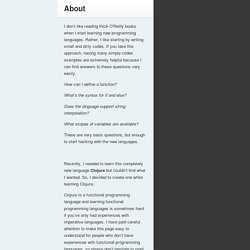
Rather, I like starting by writing small and dirty codes. If you take this approach, having many simple codes examples are extremely helpful because I can find answers to these questions very easily. How can I define a function? What’s the syntax for if and else? Does the language support string interpolation? What scopes of variables are available? Clojure xmi. Programming Digressions. Languages for the effective, daily practice of the software craft nowadays, I would point to Java and Scala as being absolutely indispensable.
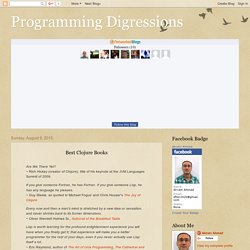
At the same time, it's undeniably helpful to have in one's toolbox—programming models, if you will—tools from programming paradigms. I say so because I know full well the inevitability of the need to wield tools from whichever programming paradigm is up to snuff for slaying a particular, wicked problems. With that rather lofty assertion, I submit to you Scala enthusiasts should note that (1) this post is a direct analog of a recent post that has corresponding thoughts on the finest Scala books, and (2) this post on the best Clojure (think Lisp) books is also highly relevant to you.
Allow me to elaborate very briefly: The programmer who has done justice to the notion expressed in the second of the two preceding points—in underscoring the eminent relevance of Lisp to Scala—is David Pollak. With that, let's foray into the land of Clojure... Clojure-cookbook/clojure-cookbook. Functional Reactive Programming in Clojurescript. Clojure Cookbook: XML/HTML Processing - Getting Clojure. Traversing an XML Document Problem How do I work with XML documents?
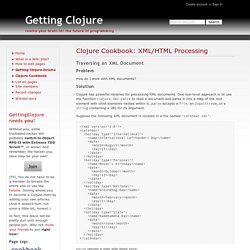
Solution. Clojure zippers: structure editing with your mind - josf.info. …but editable? What about modifying the tree, though? What happens then? It turns out that simple edits are simple. Getting acquainted with Clojure zippers - josf.info. ClojureDocs - Community-Powered Clojure Documentation and Examples. Clojure Cheat Sheet (Clojure 1.5 - 1.8, sheet v37) Primitives Numbers Strings Other Collections Collections Lists (conj, pop, & peek at beginning) Vectors (conj, pop, & peek at end) Sets Maps Queues (conj at end, peek & pop from beginning) Relations (set of maps, each with same keys, aka rels) ClojureDocs - Community-Powered Clojure Documentation and Examples.
Functional XML editing using zippers in Clojure → pckl.me. Korny's Blog. "XML is like violence - if it doesn't work, use more" Clojure is awesome for parsing and processing structured data. It has a wide range of functions for handling lists, maps (associative arrays), sets, and (if you really need them) objects. One great example of the power of clojure for this sort of thing is processing xml. You may hate xml, you may use json or edn or yaml or anything else you can - but ultimately, xml is still all over the place, and if you need to handle complex xml or large xml, you might want to look at clojure.
Contents Introduction As I said at the start, handling XML in clojure is awesome - but the documentation is all over the place, especially as you need to use several different libraries together (this being the clojure way - prefer small composable functions over monolithic frameworks). Clojure Documentation. This work is licensed under a Creative Commons Attribution 3.0 Unported License (including images & stylesheets). The source is available on Github. What Version of Clojure Does This Guide Cover? This guide covers Clojure 1.4 and Leiningen 2.x. Overview. Clear View Training. Clojure for the Brave and True. As you read this hilarious book, you will at some point experience a very serious moment. It is the moment you admit to yourself that programming is more enjoyable after knowing some Clojure. It is also the moment that your investment in this book, in money and time, comes back to you—with interest.
Quil Intro.